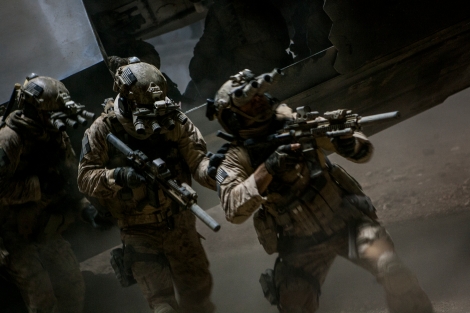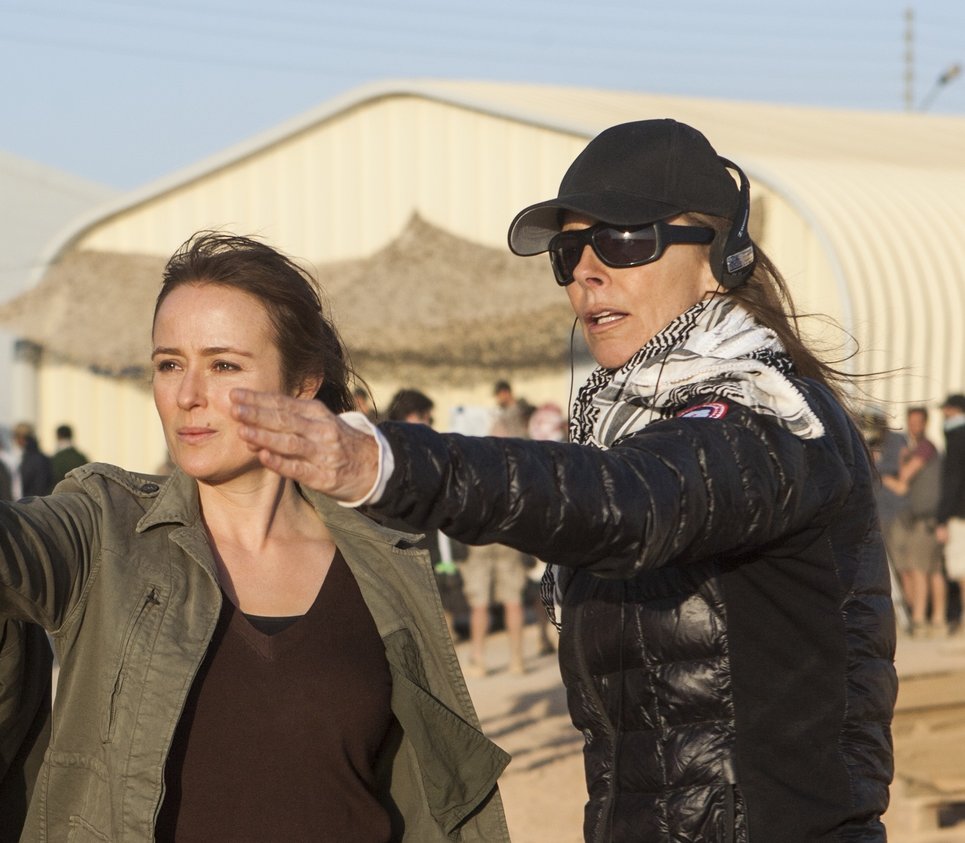Thomas J. McLean is an AwardsLine contributor. This article appeared in the Dec. 19 issue of AwardsLine.
Fast and furious is perhaps the best way to describe the making of Zero Dark Thirty, something Jessica Chastain found out the day after attending last year’s Oscar ceremony.
“I flew 25 hours to Chandigarh, India. I got off the plane and I called in, just kind of joking, ‘I’m here guys, ready to go!’ ” Chastain recalls. “And they said, ‘OK, come on in!’ I didn’t go through hair and makeup—nothing. They put me in a robe, they sent me to a market, I had no idea what time of day it was, and they just started shooting. And it was like that from the get-go.”
Rarely are movies put together as rapidly and with as much timeliness as Zero Dark Thirty, which recounts the decade-long hunt for Osama bin Laden and culminates in the May 1, 2011, U.S. Navy SEAL raid that killed the 9/11 terrorist leader.

Director Kathryn Bigelow, who became the first woman to earn the best director Oscar for 2008’s Iraq War drama The Hurt Locker, says the story was too compelling to not do. “I suppose there were certainly a lot of options out there, which I was grateful for, but I really felt that this was the story to tell,” she says. “It’s a mystery, it’s a story that was out there, and I think has touched many, many, many lives the world over, and I felt it was a great opportunity to tackle this.”
Bigelow also relished the chance to continue working with Mark Boal, who wrote the Oscar-winning screenplay for The Hurt Locker and tapped into his experience as a journalist to uncover and write the story behind the raid. “I appreciate the scope and the challenges that he writes into his screenplays,” Bigelow says.
Boal and Bigelow originally planned to shoot a movie about bin Laden eluding capture in the mountains of Tora Bora in 2001, and were close to starting principal photography when the al Qaeda leader was killed in Abbottabad, Pakistan.
Starting from scratch, Boal dove into researching the events that lead to the raid. Working with the public-affairs offices of various government agencies as well as tapping into contacts he had accumulated as a journalist covering America’s post-9/11 wars and the veterans who fight them, Boal assembled the script quickly from first-hand accounts.
The energy Boal put into the script was perfect for Bigelow. “He was certainly reporting this story as it was unfolding, and there’s a kind of urgency and timeliness to that,” she says. “And at the same time, I think we both felt a responsibility to tell it in a certain way, to tell it responsibly, and to be faithful to the research.”
Backing the production was producer Megan Ellison, who funded the movie through her Annapurna Pictures shingle. Bigelow says Ellison was tremendously supportive of the project and the filmmakers’ desire to get it right. “We were fortunate that she agreed to finance the movie and enable us to retain creative control,” she says.

The script ended up with more than 120 speaking roles and 112 sets, with the lead role of Maya—a CIA analyst who unapologetically and obsessively tracks down bin Laden in order to kill him—requiring an actress who could portray steely resolve while navigating the labyrinthine world and linguistic gymnastics of real-life espionage.
Chastain, a first-time Oscar nominee for The Help, was Bigelow’s first choice for the role. “I just felt that her intensity, her focus, her innate intelligence was something that would give the character an incredible amount of credibility,” she says.
Among the keys for getting into Maya’s head was learning the reality of life as a CIA analyst—including the importance of status in that world, which is essential to Maya’s character arc. “Maya is at the very bottom end of it and as she actually starts to fight back against it, she claims her own status to get people to listen to her,” Chastain says.
The intensity of shooting on a very tight schedule in such distant places as Jordan and India also informed Chastain’s take on Maya. “Being a woman in that part of the world, it changes your energy and your physicality,” says Chastain. “It desexualizes you because you don’t want to be seen as a woman.”
Among the most challenging scenes were the realistic portrayals of torture, including a sequence in which Dan, a CIA interrogator played by Jason Clarke, waterboards a suspected al Qaeda informant.
“As an actor, I was relieved that Mark and Kathryn were telling the whole story. These things happened,” says Clarke. “We shot it quite quickly. It was set up in an environment that was as realistic as possible. (With) the other actor, we established the bond we needed to trust each other.”
The logistics were a big and satisfying challenge for Bigelow to tackle. “We were shooting on and prepping on two continents simultaneously, in India and in Jordan, and we had to choreograph the entire raid early in preproduction, which meant you had to have figured out that whole section of the movie, which is arguably the most difficult to shoot, when you’re probably eight weeks out,” she says.
For the raid sequence that is the climax of the movie, the production re-created bin Laden’s Pakistan compound as completely as possible. The model had to not only look as accurate as possible, it had to accommodate the shoot—including having a strong enough foundation to withstand the rotor wash from the Black Hawk helicopters that were going to hover over it, says Bigelow.
“That had to all be choreographed—all of our shots, everything about that structure, how we were going to shoot it—well before we started principal photography and well before we were to shoot the raid in the first place, which was not going to be shot until mid to late April,” says Bigelow.
From the start, the subject matter drew unexpected political attention, with pundits and pols assigning partisan motives to the movie before it even had a script and inaccurately reporting that the production was given inappropriate access to classified material.
Even with the film finished, the political reactions are unexpected. “People seem to be misreading the film as advocating torture, which is just preposterous,” Boal says. “If you actually look at the film, we show the torture not yielding information and not preventing an attack—that information is coughed up over a civilized lunch. I guess this is par for the course of making something that touches people’s political turf.”

